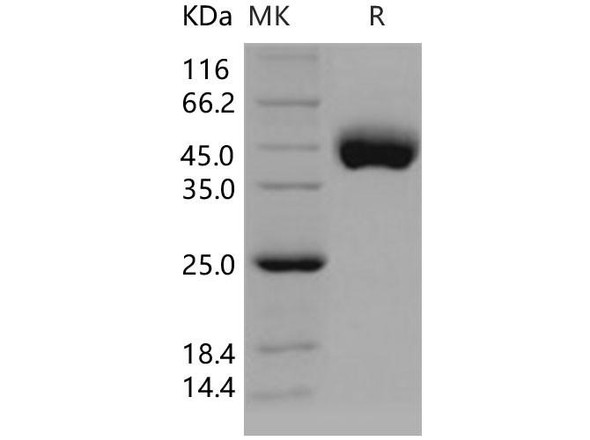CD Antigens Recombinant Proteins
Human CD21 Recombinant Protein (RPPB3033)
- SKU:
- RPPB3033
- Product Type:
- Recombinant Protein
- Species:
- Human
- Uniprot:
- P20023
- Research Area:
- CD Antigens
Description
| Product Name: | Human CD21 Recombinant Protein |
| Product Code: | RPPB3033 |
| Size: | 10µg |
| Species: | Human |
| Target: | CD21 |
| Synonyms: | Complement receptor type 2, Cr2, Complement C3d receptor, Epstein-Barr virus receptor, EBV receptor, CD21 antigen, CR2, C3DR, CD21, SLEB9. |
| Source: | Sf9 Insect cells |
| Physical Appearance: | Sterile Filtered colorless solution. |
| Formulation: | The CD21 solution (0.5mg/ml) contains 10% Glycerol and Phosphate Buffered Saline (pH 7.4). |
| Stability: | Store at 4°C if entire vial will be used within 2-4 weeks. Store, frozen at -20°C for longer periods of time. For long term storage it is recommended to add a carrier protein (0.1% HSA or BSA).Avoid multiple freeze-thaw cycles. |
| Purity: | Greater than�95.0%�as determined by SDS-PAGE. |
| Amino Acid Sequence: | ISCGSPPPIL NGRISYYSTP IAVGTVIRYS CSGTFRLIGE KSLLCITKDK VDGTWDKPAPKCEYFNKYSS CPEPIVPGGY KIRGSTPYRH GDSVTFACKT NFSMNGNKSV WCQANNMWGPTRLPTCVSVF PLECPALPMI HNGHHTSENV GSIAPGLSVT YSCESGYLLV GEKIINCLSSGKWSAVPPTC EEARCKSLGR FPNGKVKEPP ILRVGVTANF FCDEGYRLQG PPSSRCVIAGQGVAWTKMPV CEEIFCPSPP PILNGRHIGN SLANVSYGSI VTYTCDPDPE EGVNFILIGESTLRCTVDSQ KTGTWSGPAP RCELSTSAVQ CPHPQILRGR MVSGQKDRYT YNDTVIFACMFGFTLKGSKQ IRCNAQGTWE PSAPVCEKEC QAPPNILNGQ KEDRHMVRFD PGTSIKYSCNPGYVLVGEES IQCTSEGVWT PPVPQCKVAA CEATGRQLLT KPQHQFVRPD VNSSCGEGYKLSGSVYQECQ GTIPWFMEIR LCKEITCPPP PVIYNGAHTG SSLEDFPYGT TVTYTCNPGPERGVEFSLIG ESTIRCTSND QERGTWSGPA PLCKLSLLAV QCSHVHIANG YKISGKEAPYFYNDTVTFKC YSGFTLKGSS QIRCKADNTW DPEIPVCEKE TCQHVRQSLQ ELPAGSRVELVNTSCQDGYQ LTGHAYQMCQ DAENGIWFKK IPLCKVIHCH PPPVIVNGKH TGMMAENFLYGNEVSYECDQ GFYLLGEKKL QCRSDSKGHG SWSGPSPQCL RSPPVTRCPN PEVKHGYKLNKTHSAYSHND IVYVDCNPGF IMNGSRVIRC HTDNTWVPGV PTCIKKAFIG CPPPPKTPNGNHTGGNIARF SPGMSILYSC DQGYLLVGEA LLLCTHEGTW SQPAPHCKEV NCSSPADMDGIQKGLEPRKM YQYGAVVTLE CEDGYMLEGS PQSQCQSDHQ WNPPLAVCRS RVEHHHHHH |
CD21 is expressed strongly on mature B cells, follicular dentritic cells and weakly on immature thymocytes and T lymphocytes. In B-cell ontogeny, CD21 appears after the pre-B-stage, is maintained during peripheral B-cell development and is lost upon terminal differentiation into plasma cells. CD21 expression is also gradually lost after stimulation of B cells in vitro. CD21 functions as receptor for C3d, C3dg and iC3b Complement components, for EBV and for IFNalpha. CD21 binds to CD23 and associates with CD19, CD81 and Leu13 to form a large signal-transduction complex involved in B cell activation.
CD21 Human Recombinant produced in Sf9 Baculovirus cells is a single, glycosylated polypeptide chain containing 959 amino acids (21-971aa) and having a molecular mass of 105.2kDa.CD21 is fused to an 8 amino acid His-Tag at C-terminus and purified by proprietary chromatographic techniques.
| UniProt Protein Function: | CR2: Receptor for complement C3Dd, for the Epstein-Barr virus on human B-cells and T-cells and for HNRPU. Participates in B lymphocytes activation. Genetic variations in CR2 are associated with susceptibility to systemic lupus erythematosus type 9 (SLEB9). Systemic lupus erythematosus (SLE) is a chronic autoimmune disease with a complex genetic basis. SLE is an inflammatory, and often febrile multisystemic disorder of connective tissue characterized principally by involvement of the skin, joints, kidneys, and serosal membranes. It is thought to represent a failure of the regulatory mechanisms of the autoimmune system. Defects in CR2 are the cause of immunodeficiency, common variable, type 7 (CVID7). A primary immunodeficiency characterized by antibody deficiency, hypogammaglobulinemia, recurrent bacterial infections and an inability to mount an antibody response to antigen. The defect results from a failure of B-cell differentiation and impaired secretion of immunoglobulins; the numbers of circulating B cells is usually in the normal range, but can be low. Belongs to the receptors of complement activation (RCA) family. 4 isoforms of the human protein are produced by alternative splicing. |
| UniProt Protein Details: | Protein type:Membrane protein, integral; Receptor, misc. Chromosomal Location of Human Ortholog: 1q32 Cellular Component: receptor complex Molecular Function:complement binding; DNA binding; protein homodimerization activity Biological Process: B cell differentiation; B cell proliferation Disease: Immunodeficiency, Common Variable, 2; Immunodeficiency, Common Variable, 7; Systemic Lupus Erythematosus, Susceptibility To, 9 |
| NCBI Summary: | This gene encodes a membrane protein, which functions as a receptor for Epstein-Barr virus (EBV) binding on B and T lymphocytes. Genetic variations in this gene are associated with susceptibility to systemic lupus erythematosus type 9 (SLEB9). Alternatively spliced transcript variants encoding different isoforms have been found for this gene.[provided by RefSeq, Sep 2009] |
| UniProt Code: | P20023 |
| NCBI GenInfo Identifier: | 215273962 |
| NCBI Gene ID: | 1380 |
| NCBI Accession: | P20023.2 |
| UniProt Secondary Accession: | P20023,Q13866, Q14212, Q53EL2, Q5BKT9, Q5SR46, Q5SR48 C9JHD2, |
| UniProt Related Accession: | P20023 |
| Molecular Weight: | |
| NCBI Full Name: | Complement receptor type 2 |
| NCBI Synonym Full Names: | complement component 3d receptor 2 |
| NCBI Official Symbol: | CR2�� |
| NCBI Official Synonym Symbols: | CR; C3DR; CD21; CVID7; SLEB9�� |
| NCBI Protein Information: | complement receptor type 2 |
| UniProt Protein Name: | Complement receptor type 2 |
| UniProt Synonym Protein Names: | Complement C3d receptor; Epstein-Barr virus receptor; EBV receptor; CD_antigen: CD21 |
| Protein Family: | Complement receptor |
| UniProt Gene Name: | CR2�� |
| UniProt Entry Name: | CR2_HUMAN |






